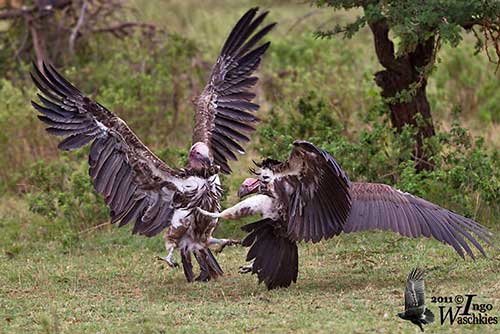
Lappet-faced Vulture
Torgos tracheliotus
Accipitriforme Order – Accipitridae Family
BIOMETRICS:
Length: 95-115 cm
Wingspan: 255-290 cm
Weight: 5400-9400 g
LONGEVITY: Up to 30 years
DESCRIPTION:
Lappet-faced Vulture is very large. In East Africa, it is usually smaller, about 6200g.
Head and strong neck are rather pink, but the colour depends on mood and temperature. Head and neck are bare, without any feathers. The strong bill is well adapted for tearing up the flesh. Feet are grey.
Fr: Vautour oricou
All : Ohrengeier
Esp: Buitre Orejudo
Ital: Avvoltoio orecchiuto
Nd: Oorgier
Russe: Африканский ушастый гриф
Sd: Örongam
Photographers:
Steve Garvie
RAINBIRDER Photo galleries
Tom Merigan
Tom Merigan’s Photo Galleries
Ingo Waschkies
Bird Photography
Callie de Wet
GALLERY
Text by Nicole Bouglouan
Sources:
HANDBOOK OF THE BIRDS OF THE WORLD Vol 2 by Josep del Hoyo-Andrew Elliot-Jordi Sargatal - Lynx Edicions - ISBN: 8487334156
BIRDS OF AFRICA SOUTH OF THE SAHARA by Ian Sinclair and Peter Ryan - Princeton University Press Princeton and Oxford - ISBN: 0691118159
BIRDS OF PREY OF AFRICA AND ITS ISLANDS by Alan and Meg Kemp - Struik Publishers - ISBN: 1770073698
GUIDE DES RAPACES DIURNES – Europe, Afrique du Nord et Moyen-Orient de Benny Génsbol – Delachaux et Niestlé – ISBN : 2603013270
Wikipedia (Wikipedia, The Free Encyclopedia)
BirdLife International (BirdLife International)
Other article: The Old World Vultures


The plumage is dark, almost black on the wings, and pale brown to white on flanks and thighs.

Juvenile is brown with few down on the head. Bill is dark horn-coloured. The underparts do not show any pale areas.
We find three subspecies:
T.t. tracheliotus, from SW Morocco, S Mauritania, eastwards to Ethiopia and Kenya, southwards to South Africa.
T.t. nubicus, from Egypt and Sudan.
T.t. negevensis, from S Israel and Arabian Peninsula.
VOICE:
Lappet-faced Vulture is usually silent.
HABITAT:
Lappet-faced Vulture frequents steppes and deserts with isolated trees such as flat-topped acacias where it may build the nest.
It needs open and arid areas, including mountains and semi-desert.
It may breed up to 2800 metres of elevation.
RANGE:
SW Morocco, S Mauritania, to Ethiopia and Kenya, and to South Africa.

BEHAVIOUR :
Lappet-faced Vulture usually lives in pair, but we can see flocks of up to 50 vultures mixed with other raptors around carcasses or at water.
It dominates all other birds of prey around the food, performing some displays such as bounding attacks, but it spends more time in these displays than feeding, and it returns later to the carcass.

Lappet-faced Vulture uses its strong bill to tear up skin and tendons. It also steals food to other raptors feeding close to him. It often feeds first, because it is the most adapted to tear up the skin and starting the feast. The strong, large bill easily tears up the flesh, and thanks to the bare head and neck, it is able to dig about into the carcasses without blood on its feathers.


Lappet-faced Vulture is often solitary, but we can see it sometimes in small groups. It can live up to 30 years in wild, but it may reach up to 50 years in captivity.
There are not regular migratory movements, except in West Africa where the Lappet-faced Vulture moves northwards during the rainy season, and southwards during the dry period.
FLIGHT:
Lappet-faced Vulture flies by drawing circles with flat wings and slightly hanging hand. When soaring, wings are flattened too, very slightly bent backwards.

REPRODUCTION:
Lappet-faced Vulture usually breeds during the dry season.
Pairs nest solitary, and build large, bulky, flat nest (about 2 metres of diameter), with small sticks at thorny tree-top. The interior is lined with dry grasses.
Female lays only one egg in the depression in the middle of the nest. Incubation lasts about 7 to 8 weeks, by both parents.
The chick is covered first with white down, except on head and neck which are grey. The second down is grey.
The young fledge at 125-135 days after hatching. It may be regularly fed by both adults for one year more.

DIET:
Lappet-faced Vulture feeds on carrion, pieces of skin and bones from carcasses of different sizes. It often feeds on garbage, and may kill some small animals, mainly small birds, but it also pirates from other raptors.

